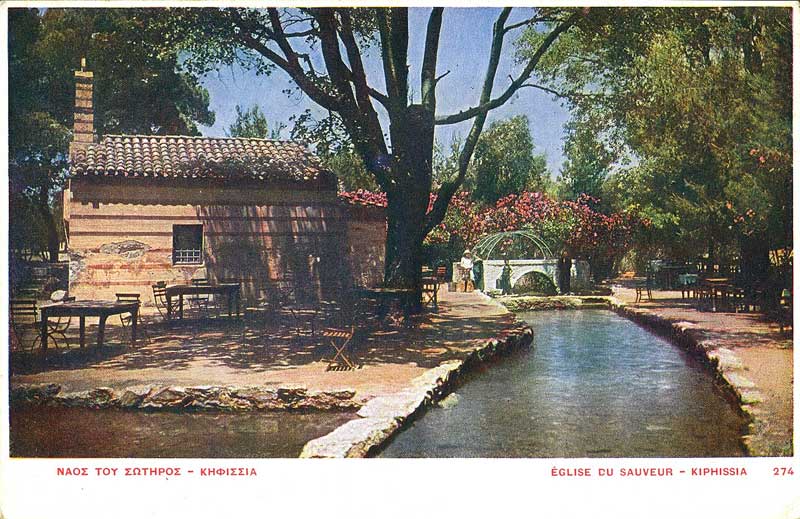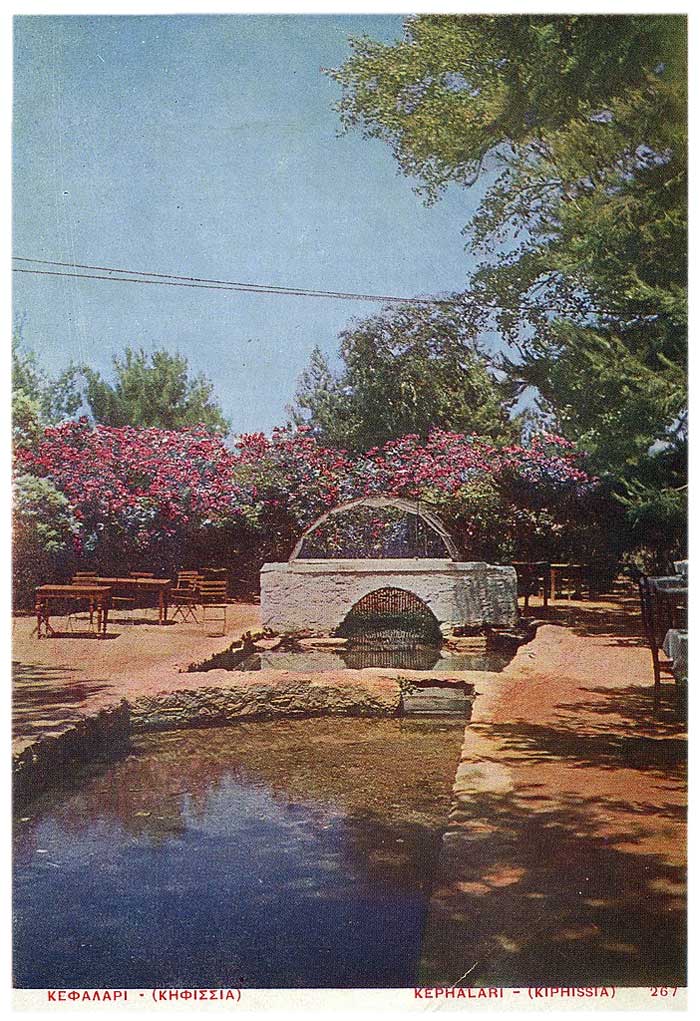.
Administrative Region : Attica
Regional unit : North Athens
Kifissia (Greek: Κηφισιά, pronounced [cifiˈsja]; Ancient Greek: Κηφισία; Latin: Cephisia) or Kifisia is one of the most expensive[1] northern suburbs of Athens, mainly accessed via Kifissias Avenue, running all the way from central Athens up to Theseos Avenue in the suburb of Nea Erythraia. It has traditionally been home to the major Greek political families. It is home to ISAP's terminal station, presently a part of the Athens Metro project. The Cephissus river runs to the west of Kifissia and has his name derived from Kifissia, and half of the municipality is taken up by part of the Penteli mountain; the rest is made up of elegant urban areas to the west, surrounded by popular and upmarket areas such as Kefallari and Politeia to the north, and Nea Kiffisia to the south-west. Kifissia is a famous recreational neighbourhood for people of all ages (but mostly teenagers) from all over Athens, because of its many available forms of entertainment; the Cinemax Cinemas, the Kifissia Bowling Center, numerous more fashionable shopping malls, as well as many smaller designer shops and upmarket restaurants, bars and nightclubs. It is also home to the Kefalari Park, the most popular place for younger groups to socialize.
Municipality
The municipality Kifissia was formed at the 2011 local government reform by the merger of the following 3 former municipalities, that became municipal units:[2]
Ekali
Kifissia
Nea Erythraia
Quarters or Neighbourhoods
Adames
Ano Kifissia
Kato Kifissia
Kefalari
Nea Kifissia
Politia
History
Antiquity
Further information: Ancient Greece

Kifissia, Church of the Saviour.
Kifissia, as Cephissia, dates back to ancient times, along with the ancient municipality of Epicephesia. It was the home of the famous dramatist Menander (circa 342-291 BC).[3] Kifissia had become a famous retreat of philosophers during the reign of the Roman emperor Hadrian, when the wealthy Herodes Atticus of Marathon, Greece built the Villa Kifissia. In his Attic Nights, Aulius Gellius describes the unique ambiance of intellectual ferment and aristocratic leisure in an idyllic setting which he created there. It was also the practice of Herodes to provide free instruction in philosophy for selected youths from Athens. The remains of the some of his family funeral monuments lie at the centre of the town in Platonas Square. He also beautified a sanctuary to the Nymphs in the ravine of Kokkinara, in the nearby district of Kefalari.[4]

Kefalari in Kifissia. Postcard c. 1915.
Medieval period
The history of Kifissia during the medieval period is obscure, but the remains of a monastery church dedicated to the Virgin of the Swallow (Panaghia Chelidonas)is associated with a story about a battle fought there between local people and unspecified "invaders". This chapel is a rare example of a monastery church originally provided with a fireplace, for the chimney remains.[5]
The monastery chapel of the Virgin of the Swallow (Panaghia Chelidonas).
Ottoman Era
Further information: Ottoman Greece
During Ottoman period, in 1667, Kifissia was visited by the Turkish traveler Evliya Tchelebi. He described a small country town set in a fertile plain of paradisaic beauty, with three hundred tile-roofed houses. Half the inhabitants of the town were Muslims and half were Christian. He records that there was a single mosque, without a minaret, and many small Christian chapels - some of which survive today.[6]
Post Greek Independence
Further information: Greek War of Independence
The temperature in Kifissia tends to be significantly lower than that of the city, so following the independence of Greece, it quickly became a summer resort of the ruling class of the new state.
Its popularity faded somewhat during the middle of the Nineteenth Century when the danger of raids by brigands who infested the nearby mountains was very real. However, the suppression of brigandage, and the arrival of the railway in 1885, led to the dramatic development of the area.
It became the fashion for wealthy Athenian families to build summer houses in Kifissia, and keen social competition led to the creation of a unique architectural ambiance, as villas in ever more exotic styles proliferated. For those unable to afford a summer house, many hotels were built, where the slightly less affluent could spend the holiday months rubbing shoulders with their social betters.
The heyday of Kifissia was probably during the inter-war period, when the leaders of the two main rival political parties frequented different hotels in the town together with their most important supporters.[7]
World War II and Civil War
Further information: Axis Occupation of Greece during WWII and Greek Civil War
Following the liberation of Greece from German occupation in 1944, the British Royal Air Force ill-advisedly made its headquarters in Kefalari, taking over several hotels. With the outbreak of the Greek Civil War, the RAF personnel were first besieged, then forced to surrender, and marched across the mountains into northern Greece; being released in Trikala only after a truce had been arranged.[8]
Modern Kifissia
Today, Kifissia is an upmarket shopping centre, although many villas have been preserved.
In July 2007, residents panicked as Kifissia was struck by a bush fire the origins of which are said to be arson related. The fire destroyed much of the eastern, partially forested parts of the area. It several houses and buildings that had been built near the forest boundaries but did not cause as much damage as the fire in the Penteli region. The fire lasted several hours, finally being put out at about midnight. Firefighters made use of helicopters as well as airplanes to battle the blaze.
Economy
Aegean Airlines, Eurobank and Eltrak have their head office in Kifisia.[9]
Historical population
Year Population
1951 12,991
1981 31,876
1991 39,166
2001 43,929
Persons
Menander (circa 342-291 BC), dramatist, born in Kifissia
Emmanuel Benakis, merchant and politician, died in Kifissia
Andreas Empeirikos (1901 in Romania - August 3, 1975), poet, born in Kifissia
Penelope Delta (1874 Alexandria – 27 April 1941)
Theodoros Pangalos, general, died in Kifissia
Themistoklis Sophoulis, politician, died in Kifissia
Evgenios Spatharis (1924–2009), shadow theatre artist, born in Kifissia
References
^ "Travel: Extra day in Athens". Northstar Travel Media (USA Today). 2003-08-07. Retrieved 2007-12-29.
^ Kallikratis law Greece Ministry of Interior (Greek)
^ Rossiter, Stuart, Greece, Ernest Benn Ltd., London (1977) p185
^ Tomkinson, John L. Athens, Anagnosis Books, Athens (2006) pp217-222
^ Tomkinson, John L. Athens, Anagnosis Books, Athens (2006) pp224
^ Tomkinson, John L. Athens, Anagnosis Books, Athens (2006) pp225
^ Tomkinson, John L. Athens, Anagnosis Books, Athens (2006) pp225-227
^ Tomkinson, John L. Athens, Anagnosis Books, Athens (2006) pp231
^ "Headquarters." Aegean Airlines. Retrieved on 22 February 2010.
Greece :
A - B - C - D - E - F - G - H - I - J - K - L - M -
N - O - P - Q - R - S - T - U - V - W - X - Y - Z
| Ancient Greece
Science, Technology , Medicine , Warfare, , Biographies , Life , Cities/Places/Maps , Arts , Literature , Philosophy ,Olympics, Mythology , History , Images Medieval Greece / Byzantine Empire Science, Technology, Arts, , Warfare , Literature, Biographies, Icons, History Modern Greece Cities, Islands, Regions, Fauna/Flora ,Biographies , History , Warfare, Science/Technology, Literature, Music , Arts , Film/Actors , Sport , Fashion --- |
Retrieved from "http://en.wikipedia.org/"
All text is available under the terms of the GNU Free Documentation License


